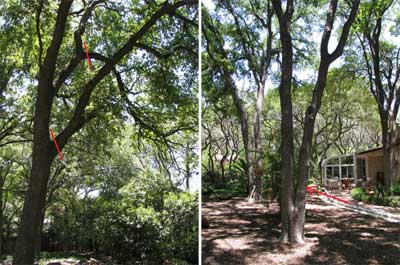Question and Answer – July 2011
Neil enjoys answering gardeners’ questions. All he asks are (1) a photo to accompany the question in e-gardens – you’ll see that he only answers those questions with photos here, and (2) that you tell him where you live (city), so that he can give you a more accurate answer. He answers questions of the most general reader interest.
Question: What is the remedy for the severe bark split in my mature Japanese maple? D.B., Lake Highlands (Dallas).
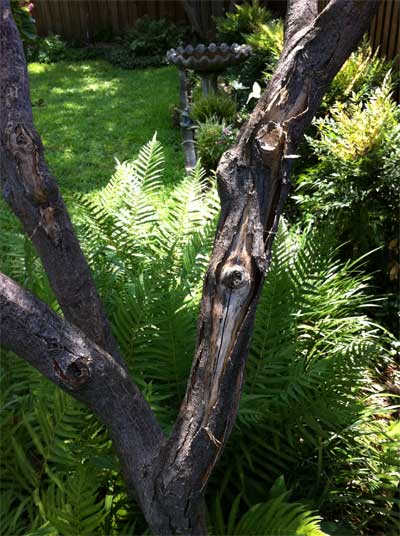
Answer: This damage has been there for a long time (probably several years), as evidenced by the very dry and cracking internal wood. It most likely resulted from leaving a stub of a branch during pruning. You’ll see one such stub toward the upper right of your photo. The tree has tried to heal itself, but it appears that it’s not going to succeed, at least not in the tissues that are visible here. There isn’t much that can be done now other than wait and see.
Question: My tomatoes all died from some type of blight or fungus. Is there anything I can do to stop this next year? J.W., Aledo.
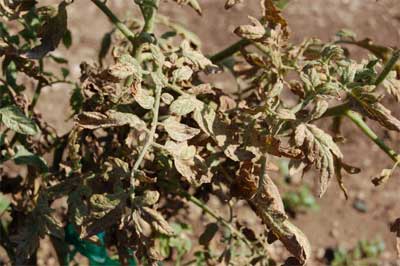
Answer: This is spider mite damage. Spring 2011 was a horrible year for them, primarily because it turned so hot and stayed so dry. Learn to recognize the early symptoms, and treat at first evidence next time around. Click here to see my comments in the Most Asked Questions section of my website.
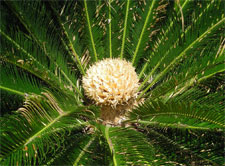
Question: I have a large sago palm that suffered winter damage, even though I tented it. It always puts out new leaves. This year, it’s putting out a flower. What should I do to keep it attractive? Will it put out new leaves? What should I do with the leaves that still show freeze damage? S.B., no city given.
Answer: Just let nature take its course. The plant will eventually produce new leaves and new stems that will conceal the damage. You must be fairly far south in Texas, or the plant must be in a really protected spot. Most cycads were hurt a lot more than yours.
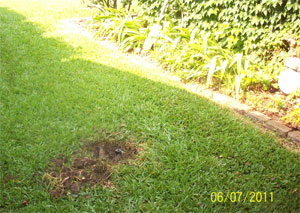
Question: I have uncovered a tree root that is 37 feet from a sweet gum and 50 feet from a live oak. I suspect it’s from the sweet gum. It appears to be heading for the neighbor’s backyard. What should I do with it? No name, no city given.
Answer: That root is really random, isn’t it? Cut it somewhere convenient. It won’t hurt the tree at all, and you really don’t need it that close to the surface, nor do you want it that close to a sprinkler. Fall would be the ideal time to remove it, but do so now if you have to.
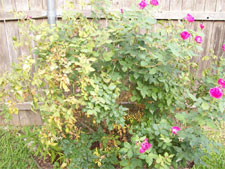
Question: What is happening to my Knockout rose? I thought they were indestructible. They just appear to be dying quickly. S.H., Dallas.
Answer: Your photo looks like the plant is either suffering from cotton root rot, a serious soil-borne fungal disease, or from drought. If you’re sure you have kept it watered properly all through this season so far, the disease might very well be involved. It can lie dormant in the soil for years, then suddenly kill plants. Many different types of plants are susceptible, and roses are high on the list. There is no chemical control. You’ll need to replant with other types of flowers and shrubs that are not bothered by the disease. Visit with a Texas Master Certified Nursery Professional for advice on the best types for your needs. (You will see another question regarding this disease, below.)
Question: I discovered damage being done to a red oak. The trunk was affected, and I was able to dig one of the larvae out. What is it, and how can I treat it? J.A., Austin.
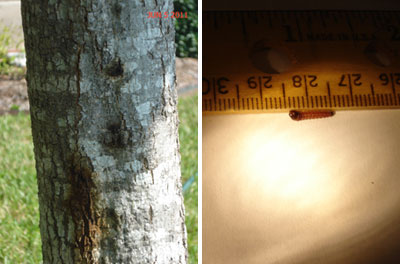
Answer: This is a wood borer, and it probably moved into your red oak soon after planting. Usually, they are "invited" into young red oak trees when we fail to wrap the trunks with paper tree wrap for their first couple of years in our landscapes. They lack bark, so their trunks often split from sunscald, and the borers move into the wounds. At this point, run a soft wire into the tunnels and skewer as many of the larvae as you can find. No spray will help, nor will wrapping the trunk at this late date.
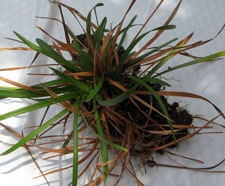
Question: We replaced old English ivy with liriope about 18 months ago. Within a month or so, the liriope began to die in one area. The landscaper replaced about one-third of the plants, but the dieback has continued to spread. Are we over-watering it, or is there some kind of problem present in the soil? M.B., Waco.
Answer: As good as your photos are, I can’t determine the cause of the problem. There certainly are soil-borne funguses that attack liriope, but in my own life’s experiences, they’re a lot more common on the variegated type called Silvery Sunproof than they are on green types like you have. I would suggest sending a plant sample of the dying tissues (not completely dead plants) to the Plant Disease Diagnostic Laboratory at Texas A&M. Here is a link to their website. http://plantclinic.tamu.edu/

Question: What is wrong with my St. Augustine? It had these dead spots after the winter. V., San Angelo.
Answer: This looks like Take All Root Rot. You may have seen stories I ran about my own lawn a couple of months ago here. The disease was epidemic across Texas in Spring 2010, and it came back very strongly this year. Please click here to see a long write-up I’ve put in the Most Asked Questions part of my website. While you’re in the MAQ section, you might also look at the details of chinch bugs, gray leaf spot and brown patch, as they’re also likely to show up in your lawn before the season winds down. Like you, I have St. Augustine (and prefer it), but it really does challenge my patience.
Question: My 7-year-old crabapple did not come back this year, and now, within 10 feet, my rose-of-Sharon is almost dead. The New Dawn rose you can see is also struggling. Could this be cotton root rot? A.M., Hico.
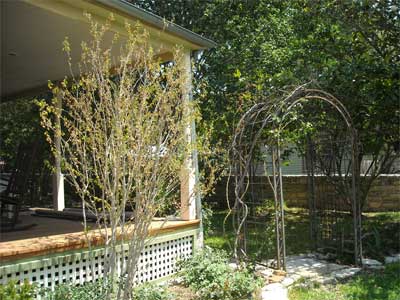
Answer: It not only could be – it is. While your diagnosis is great, the news is not so good. There is no chemical control, and all you can do is to replant with junipers, hollies, crape myrtles and other plants that are known to be highly resistant or immune to the fungus.

Question: What would cause three crape myrtles to produce these little nodules of growth on their trunks? They started after a bad hailstorm earlier this year. B.B., Prosper.
Answer: I have not seen this type of growth on crape myrtles, so I really can’t give you any advice. I guess I would ask if you have used any type of weed-and-feed product near the plants? Weedkillers cause abnormal growth. If you’ve not used one, I would guess that it’s just unusual growth brought on by the severe injury of the hailstorm. I can’t see if the plant is leafing out farther up the stems, or if it’s dried out and dead. If the latter, watch for new stem sprouts to emerge from the soil. Those can be trained to become the new trunks.
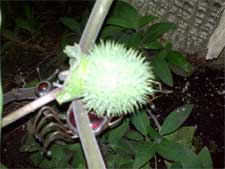
Question: This is the seedpod on my datura. Do I need to wait until fall to get the seeds? Should I store them in a sandwich bag in the refrigerator for the winter? B.M., Colleyville.
Answer: These fruit on datura (angel’s trumpet, or jimsonweed) will turn brown and crack open. At that point (and not before), the seeds will be mature and ready to harvest. Honestly, the plants will self-sow right back into the bed if you just let them ripen. You’ll always have a lot more plants than you’ll end up needing.
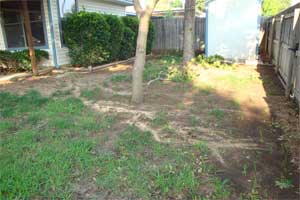
Question: I have lived in my home for 19 years, and I’m having a terrible time growing grass in my back yard. I have two sweetgum trees and one live oak. St. Augustine grows well in other parts of my yard, but people tell me this spot is too shaded. What can I do? K.M., Euless.
Answer: This is my Number 1, all-time most-asked question. So, you’re certainly not alone. Although it doesn’t look like it here, I’ll bet the "shade theory" is accurate. St. Augustine needs 4 hours of hot, direct summer sun to hold its own, and 6 hours if you expect it to grow. I have many areas in my own yard where I’ve had to convert over to shade-tolerant groundcovers like mondograss, liriope, purple wintercreeper and Asian jasmine. A person just gets tired of the constant struggle of replacing and babying grass.
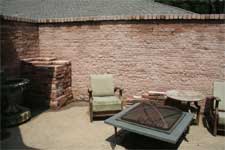
Question: Can I successfully grow and confine bamboo in this space? It’s on the west side of the house. How do I build the trench and barrier to keep it from spreading? I want to break up the "fortress" look. L.B., Dallas.
Answer: Bamboo is always going to be invasive, so you’ll be playing with horticultural fire. I would strongly encourage you to plant an attractive vine. Boston ivy would be very pretty, or you might espalier a Willowleaf holly or Hollywood twisted juniper. Buy a large, decorative wrought iron trellis, and grow Carolina jessamine or an EarthKind® climbing rose. Install wall brackets for hanging pots, and perhaps install an attractive wrought iron shelf for potted plants. As for the bamboos, most of the clumping types that don’t spread are tropical in nature, so they won’t make it through a North Texas winter.

Question: I have grown tomatoes for the first time this year, and I’ve grown them above ground in horse troughs. What causes this flat, brown bottom on the fruit? This is Persimmon Heirloom. D.D., Austin.
Answer: This is blossom-end rot. It’s brought on by letting the plants get too dry between waterings. The blossom end of the fruit is farthest from the roots, so it dries out first and gets water last. This is the same thing that happens to the tips and edges of leaves when plants get too dry. Be more vigilant in your watering next time around.
Question: This is a 4-year-old cedar elm in my front yard. This has been getting progressively worse in the last few years. The tree still seems to be green and growing. What should I do? L.H., no city given.
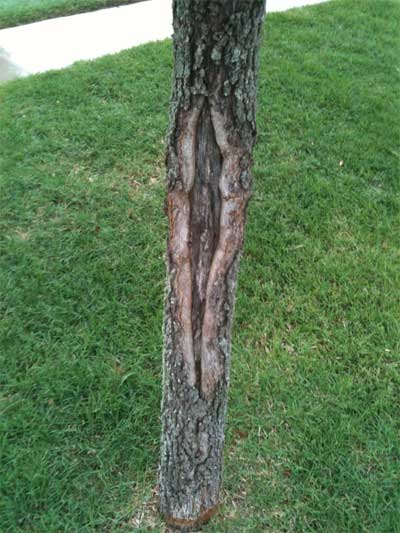
Answer: This trunk has had some type of major injury or decay, but it’s trying to heal across it. That’s what the roll of new bark that surrounds the wound is doing. Sit tight, and let nature do its work.
Question: I cannot get grass to grow beneath my live oak and cedar elms due to the excessive shade. Can I remove the branches that I have marked with red lines to let more light in? If so, at what time of year? B.C., Austin.
Answer: My vote would be that if you remove limbs of these sizes, you would seriously affect the appearance of the two trees involved. More importantly, judging from the surroundings in your yard, it will only be a matter of time until you would need to remove more branches. You are really a candidate for mondograss or some other shade-tolerant groundcover. If you do decide to remove the branches, winter would be best. (But, I’m still going to try to talk you out of it.) Take great care not to let the weight of the branches peel bark down the trunks. If that happens, you could lose the entire tree. You’ll want to use the "three-step" approach to large limb removal, where you make an undercut one-third of the way into the bottom of the branch being removed (12 inches out from the trunk), then you cut completely through the branch from the top (15 inches out from the trunk). The weight of the branch peels the bark off only as far as the undercut. Then, simply remove the remaining stub.
Question: We have been growing prickly pear and other succulent plants for more than 6 years. They have developed white blotches, and all I can find is that it might be leaf-footed bugs that are doing this damage. I’ve even started over, and they’re still here. Any suggestions? S. and P.S., North Dallas.

Answer: Here is an insightful write-up on the pest you have described: http://hillcountrymastergardeners.org/pdfs/pests_cacti.pdf. It appears that you have identified your own problem. Without your fact-finding head start, I’d probably have spent 3 hours looking. My eyes thank you!



